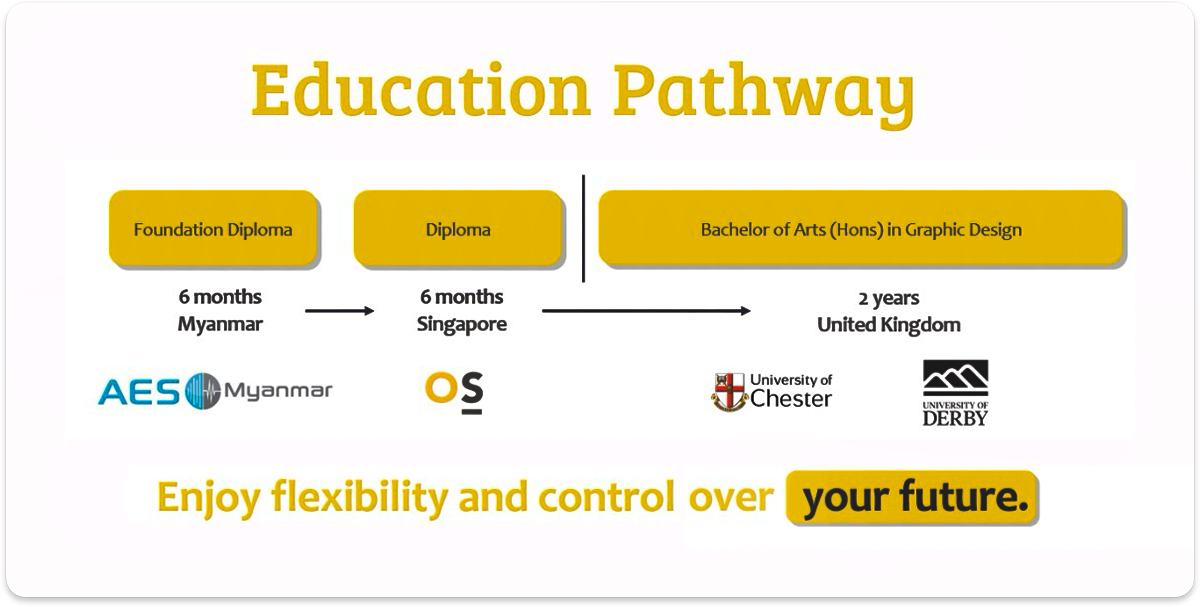Diploma in Communication Design
Course Overview
The diploma in communication design aims to offer a comprehensive, multidisciplinary design education by providing top-notch instruction in original and creative design techniques and portfolio development for students. The design department is dedicated to fostering an environment that is free-thinking and imaginative for conducting research and learning about cooperative strategies that develop students' potential through active participation in small-class settings. Our graduates are aware of the sources of knowledge and how to apply it to art, design, and communication. Graduates of the program will be qualified for a variety of positions in the creative sector, including graphic design, branding, editorial design, digital design, motion graphics, packaging design, and campaign planning. Excellent in the extreme. This cannot be missed!
Brand design
Brand design is one of the most important aspect in any business. It is the foundational piece in a business' marketing communication to its consumers. Students will be introduced to the techniques, processes and considerations in brand development, consumer connection and designing identity material. Students will be exposed to the creative process involved in the development of brand collateral and design planning. Students will also learn how to design according to brand standards and add visual appeal into their imagery.
OutcomesBy the end of the module, students will be able to do the following:
- Develop moodboards and stylescapes into concepts with a specific target audience in mind
- Design visually appealing and congruent collaterals for a brand
- Design comprehensive brand identities that effectively communicate a brand's attributes and benefits

Packaging design
Packaging design is the discipline of creating the container and its visual aspects. This container may range from a simple bottle and label to an elaborate box or system of boxes and inner packaging that a consumer buys at retail or might receive in the mail.
OutcomesBy the end of the module, students will be able to do the following:
- Apply principles of interface design and usability design to the creation of digital interfaces
- Identify trends in user interface design and incorporate them into digital interface designs
- Design and develop responsive layouts for digital interfaces using industry standard authoring tools

Digital interface design
Digital interfaces have become prevalent through web browsers, tablets, smart TVs, and smartphones. Therefore, their design is a crucial skill to help categorise the clutter of information into user-friendly digital spaces. This module focusses on designing for responsive digital platforms. Its aim is for students to design webpages and mobile apps, learn and apply basic digital authoring skills, and to provide a general understanding of programming and its functions. Students will be introduced to the techniques and processes in designing and constructing containers. They will be required to be well-versed in the production processes involved in packaging design and also appreciate the influence of culture and climate on materials. They will learn to integrate visual appeal with functionality in their design.
OutcomesBy the end of the module, students will be able to do the following:
- Select appropriate materials vis-à-vis culture and climate in designing a package
- Apply a range of materials, structure and composition techniques to create packaging designs Design a visually appealing and functional packaging for a given product that fulfills the client's needs

Adobe basics: InDesign
Adobe InDesign is a desktop publishing software used to create posters, brochures, magazines, presentations and ebooks. Students will learn how to navigate the interface of the software to work with grids and columns, pagination, linked images, et cetera, to create layouts.
OutcomesBy the end of the module, students will be able to do the following:
- Use Adobe InDesign to place and edit type and graphics
- Use Adobe InDesign tools to create multi-page layouts for a range of projects such as books, newsletters and magazines
- Produce multi-page print documents in Adobe InDesign and create a print-ready PDF file

Layout design and studio practices
Layout design is essential to setting any textual content and images in physical and digital spaces. This is paired with studio practices to inculcate proper finished artwork preparations. Students will learn the grid system and how to employ simple hierarchy and signalling techniques to create publications such as pamphlets, brochures and mailers. Students will also learn the proper housekeeping and pre-production preparations for F.A.s.
OutcomesBy the end of the module, students will be able to do the following:
- Apply the grid system and layout considerations to a simple publication
- Apply best practices and industry requirements to final artwork preparation for production

Professional design practice
This module will cover the conduct and work process, such as interview preparation, portfolio building, and work ethics and practices of the communication design and interaction design industries. Students will be guided on the considerations required to package their individual portfolio based on their strengths, works and/or direction, and gain an insight on the processes and practices in design, and understand the importance of networking, and client management.
OutcomesBy the end of the module, students will be able to do the following:
- Analyse a brief and identify the design challenges and requirements
- Conduct design research and propose a range of possible solutions to the problem
- Present a comprehensive solution, within constraints, comprising a range of design items carried out across at least two types of media
Critique their design process and solutions, identifying strengths and areas for improvement

Final Major Project (Communication Design)
This module will assess students on their ability to integrate their skills and knowledge learnt in the programme. Students are required to design a comprehensive campaign that will implement design on various media such as packaging, brochure, and website that is cascaded down from a brand identity system. Students will get the opportunity to work on authentic briefs designed with input from industry professionals and actual clients.
OutcomesBy the end of the module, students will be able to do the following:
- Prepare a professional curriculum vitae and resume
- Plan and describe a personal professional development strategy
- Design a personal portfolio to showcase strongest works in an appropriate presentation medium













